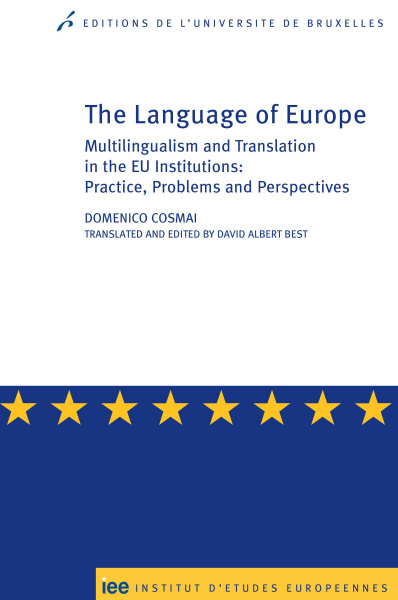The Language of Europe
Multilingualism and Translation in the EU Institutions: Practice, Problems and Perspectives
First Edition
The Language of Europe offers a clear and comprehensive introduction to the policy area of multilingualism and to translation practice within the EU institutions. Read More
This first edition in English builds on the success, among academics and practitioners alike, of its two preceding Italian editions (published respectively in 2003 and 2007 with the title Tradurre per l'Unione europea, Milan, Hoepli), which have closely followed the EU journey through its successive enlargements, and the impact of these multiple accessions on the politics and practice of institutional translation. It proposes an in-depth, up-to-the-minute analysis of the direct relationships between member-state languages and the problems of knowledge transfer between the diverse languages and cultures that make up the patchwork which is the EU.
Enriched throughout with practical examples from many among the twenty-four official languages of the European Union, specially selected and adapted for an Anglophone readership, The Language of Europe features detailed studies on the following topics: the background to and arguments in favour of EU multilingualism; the language features of EU documents; variations in translation practice between the different EU institutions, agencies and consultative bodies; the day-to-day working practice of translators and lawyer-linguists; the impact of ICT on translation practice; distinctive genres of EU institutional translation; what the future holds for EU translation.
The volume incorporates a range of sample texts from a variety of EU official languages, provided in the source-language original and English target-language translation, in order to give the student and specialist an insight into and overview of the rigour and procedural expertise which are demanded and can be seen at work from initial (co-)draft to final version in the rendering of a "multilingual" EU document.
Geared towards students, peers and specialists in Translation and Interpretation Studies, Language Studies and Cultural Studies, The Language of Europe is likely to arouse an equal level of interest in those working in adjacent scholarly domains: Cultural Geography, European Studies and Law, Political Science, and Sociolinguistics, for a start, as well as those currently pursuing or prospecting a career in the European institutions.
Specifications
- Publisher
- Éditions de l'Université de Bruxelles
- Author
- Domenico Cosmai,
- Foreword by
- José Manuel Barroso,
- Introduction by
- Domenico Cosmai, David Albert Best,
- Edited and translated by
- David Albert Best,
- Collection
- European Studies | n° 56
- ISSN
- 13780352
- Language
- English
- Supporting Website
- Oapen.org
- Publisher Category
- Publishers own classification > Language(s) & Literature(s)
- Publisher Category
- Publishers own classification > Political Science
- BISAC Subject Heading
- LAN009050 LANGUAGE ARTS & DISCIPLINES / Linguistics / Sociolinguistics
- Onix Audience Codes
- 06 Professional and scholarly
- CLIL (Version 2013-2019)
- 3080 SCIENCES HUMAINES ET SOCIALES, LETTRES
- Subject Scheme Identifier Code
- Thema subject category: Linguistics
Paperback
- Publication Date
- 03 November 2014
- ISBN-13
- 978-2-8004-1574-1
- Extent
- Main content page count : 240
- Code
- 1574
- Dimensions
- 160 x 240 x 15 cm
- Weight
- 431 grams
- ONIX XML
- Version 2.1, Version 3
Google Book Preview
Contents
- Foreword – Translating unity in diversity | José Manuel BARROSO
- Introduction
- Introduction to the English edition
- Acknowledgments for this edition (2014)
- 1. The Language Policy of the European Union
- 1.1 Legal foundations
1.2 The reasons for multilingualism
1.3 Multilingualism at work within the EU institutions
1.4 The impact of multilingualism on translation
- Appendix. Regulation no. 1, 15 April 1958 determining the languages to be used by the European Economic Community
- PART ONE – The language of European Union documents
- 2. The lexical dimension
- 2.1 New language issues in a united Europe
2.2 The genesis of EU lexicon
2.3 Integrating EU lexicon into standard language
- 3. Drafting and textual issues
- 3.1 The need for clarity in EU documents
3.2 Language interference in EU-related discourse: the case for English and Italian
- PART TWO – The characteristics of EU translation
- 4. Translation practice in the European Union institutions
- 4.1 EU translation in figures
4.2 The state of play in the EU institutions and bodies
- 5. Translating for the European Union: the operational dimension
- 5.1 EU translators
5.2 The categories of translated texts
5.3 Autonomy and constraints in translation
5.4 Revising and editing EU translations
5.5 Lawyer-linguists
- 6. The impact of ICT
- 6.1 Terminology databases
6.2 Multilingual text corpora
6.3 Machine-translation software
6.4 Computer-assisted translation
6.5 Experiments in co-translation
- 7. Distinctive genres in EU translation
- 7.1 Complexities in legal translation
7.2 Translating political and administrative texts
7.3 Final remarks
- 8. Translating for the European Union today and into the future
- 8.1 EU-28 and beyond
8.2 The new face of EU translation
8.3 What the future holds for EU translation
- 9. Selection of translated texts
- Bibliography
- List of abbreviations and acronyms
- Index


Review